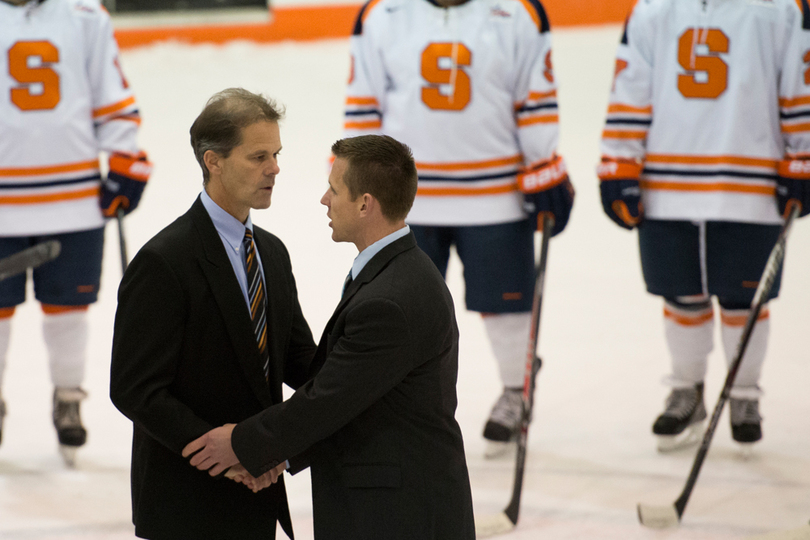Skating on thin ice: In 6th season, Syracuse searches for stability in transfers, volatile CHA

Paul Flanagan shakes hands with the Clarkson head coach. In the past five years, Flanagan has lost 10 players to transfers while building up his program in College Hockey America. Ziniu Chen | Staff Photographer
Stability was never something that Paul Flanagan expected as the Syracuse head coach.
Creating a new team in the College Hockey America with programs shuffling in and out, the prospect of acquiring four-year ice hockey players was more of a blessing than an expectation.
“Every spring, in our sport, it’s literally free agency,” Flanagan said. “You can just come in and say, ‘I don’t like it here,’ or ‘I’m not on the top power play, so I’m leaving.’”
That’s a reality Flanagan has had to face since he spearheaded the formation of SU’s women’s ice hockey program in 2008. While a one-year waiting period for transferring is the norm in other major college sports, women’s ice hockey allows players to compete immediately. In Syracuse’s first six years, 10 players transferred from the team.
But now, as the CHA is making progress, so is the Orange, which is coming off its best record in program history. This season, the Orange welcomes back almost the entirely same team that posted a 20-15-1 record last season.
Junior Shiann Darkangelo is one of the lone deserters. She transferred to Quinnipiac after last season because she wasn’t happy with her role on the team, Flanagan said.
“She thought she was going to run the team, I guess. Go someplace else and do it,” Flanagan said. “That’s exactly what happened. If you don’t like it here, you’re allowed to go through the process.”
Jordyn Burns, who transferred from Syracuse to the University of Minnesota after the 2011-12 season, said that she wanted to make the most of her four years playing college hockey.
“I wanted to be in a school that I enjoyed being at,” Burns said. “Because I knew my time for hockey was going to end soon. I think it comes down to something personal at the end of the day, because if you’re not happy, then you’re not happy.”
Though the process offers few obstacles, Flanagan insisted that many of the recruiting and retention issues stemmed from massive volatility within CHA. He feared potential recruits would be more likely to play in conferences with a more solid foundation.
“I think that hurt us,” Flanagan said, “the instability of our league, and then that created some instability from within.”
The CHA started with four members in 2002. In 2004, Findlay dropped, but was replaced by Quinnipiac. The Bobcats left a season later, but were replaced by Robert Morris. Syracuse came in 2008. Since then, Wayne State and Niagara have both left. Lindenwood, Penn State and Rochester Institute of Technology all joined in 2012.
The conference has basically teetered on the brink of extinction since its inception. In 2004, the CHA had a chance at its first tangible breakthrough. Ohio State was seriously considering becoming a part of the CHA. OSU met with several of the program’s athletic directors and was about to make a decision.
But before that happened, Findlay’s recently hired president stepped into the office of athletic director Steven Rackley. He told Rackley that he was cutting the program. With another team leaving the conference, the Buckeyes decided to go to the Western Collegiate Hockey Association.
“That was the beginning of the end for women’s hockey in the College Hockey America,” Rackley said. “I always thought that Findlay had a major effect on where that league went.
“It was just a conference of schools with nowhere else to go. And no one would have begrudged any school for leaving to join a more established conference. It was just a league where we needed to stay together to keep our programs going.”
Fast-forward nine years, and for the first time in CHA history, there is some balance. There are still only six full-time members, but many of them are improving. Syracuse had its best season in program history in 2012-13. Penn State is unveiling a new ice hockey facility this season, and Lindenwood is in the process of creating one of its own, Flanagan said.
The Syracuse roster is now full of players that intend to spend all four years with the Orange. Senior goalie Kallie Billadeau came to Syracuse ice hockey in its infancy because she wanted to be a part of something new. She said that she is happy the team has worked through its growing pains.
“It’s tough when you lose players, but I think it’s for the best,” Billadeau said. “We have a group of girls here that want to be here and are really excited to play.”
The newfound success is rooted in the stable foundation that Flanagan has spent the past five years trying to establish. He admits that the team’s winning ways overlapping with the resurrection of the CHA isn’t pure coincidence.
With three teams joining the conference in 2012, the CHA is on track to have an automatic qualifier for next year.
“Thankfully the timeline for RIT was pushed up and we were able to add three new teams,” Flanagan said. “All of a sudden, we’re a league of six.”
Though Flanagan and the team are far from satisfied with where they are, they acknowledge their direction is the right one. In the Orange’s opening game on Oct. 4, Syracuse defeated No. 10 Northeastern on the road, 4-1. It was just the fourth time Syracuse has defeated a ranked opponent.
“It’s definitely gotten better,” Billadeau said. “It’s hard to start a new program, and it’s hard to be a part of something new. But I think our team has evolved, we’ve brought in a bunch of really good players.
“We’re slowly getting there, we’re slowly getting better, and I think this year we’ll show an accumulation of what we’ve done.”




